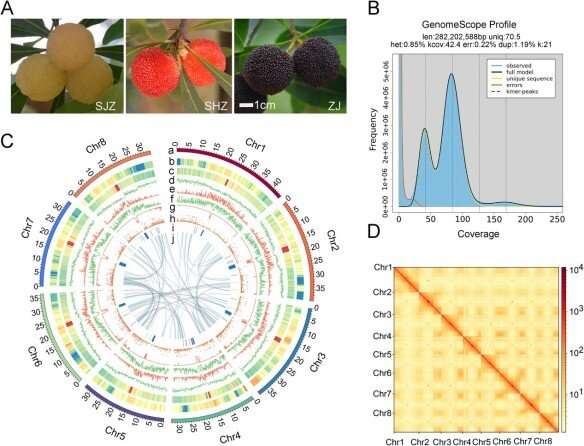This article has been reviewed according to Science X's editorial process and policies. Editors have highlighted the following attributes while ensuring the content's credibility:
fact-checked
peer-reviewed publication
proofread
Sweet secrets of the bayberry: Genetic insights set to transform fruit quality

The Chinese bayberry, Myrica rubra, is a subtropical fruit highly valued for its distinctive flavor, nutritional benefits, and economic importance. However, previous genome assemblies lacked sequence continuity, hindering comprehensive genetic studies. Due to these challenges, a detailed investigation of the genetic factors influencing bayberry fruit quality was necessary.
Researchers from the State Key Laboratory for Managing Biotic and Chemical Threats to Quality and Safety of Agro-products have made a monumental discovery. Their work, published on January 30, 2024, in Horticulture Research, details the assembly of the T2T reference genome for the cultivar "Zaojia" and a genome-wide association study (GWAS) that uncovers the genetic factors influencing bayberry fruit quality.
The study utilized PacBio HiFi long reads to assemble a 292.60 Mb T2T genome for the "Zaojia" bayberry cultivar, significantly improving genome continuity. The researchers identified 6,649,674 single nucleotide polymorphisms (SNPs) and performed a GWAS on 173 accessions, linking 1,937 SNPs to 1,039 genes associated with 28 fruit quality traits. Notably, an SNP cluster on chromosome 6 was found to regulate fruit color, involving two MYB genes and an MLP-like protein gene that increased anthocyanin production.
This study provides a comprehensive genetic resource for future bayberry breeding programs, focusing on traits like fruit color, size, and nutritional content.
Dr. Shuwen Zhang, the lead researcher, stated, "This breakthrough in assembling a gap-free reference genome for Chinese bayberry opens new avenues for genetic research and breeding. Our findings on the genetic determinants of fruit quality traits will significantly enhance the efficiency of breeding programs, leading to improved bayberry varieties with better color, size, and nutritional profiles."
The completion of this reference genome and the identification of key genetic variations have profound implications for bayberry breeding and cultivation. The genetic insights gained from this study will facilitate the development of molecular markers for targeted breeding, allowing for the selection of superior fruit traits.
Ultimately, this research will contribute to the production of high-quality bayberries, benefiting both producers and consumers. The findings also provide a valuable genetic resource for studying other related species, advancing the field of horticultural genomics.
More information: Shuwen Zhang et al, T2T reference genome assembly and genome-wide association study reveal the genetic basis of Chinese bayberry fruit quality, Horticulture Research (2024). DOI: 10.1093/hr/uhae033
Journal information: Horticulture Research
Provided by TranSpread





















